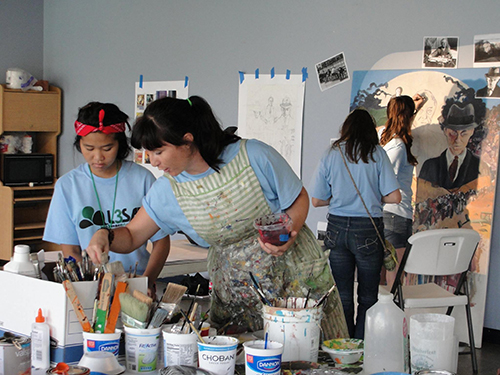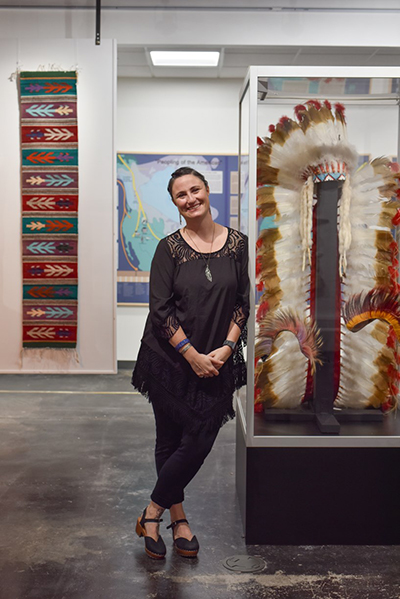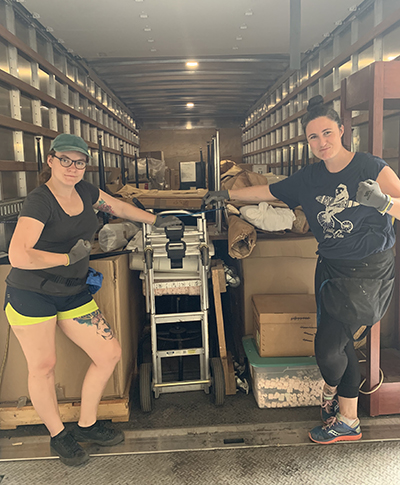ÃÏÃÏ≥‘πœ is surrounded by opportunities for community engagement‚Äî just ask School of Art alumna Francisca Ugalde Zapico. She graduated from ÃÏÃÏ≥‘πœ with her B.F.A. in Painting in 2005 and earned her M.A. in Arts Administration from The University of Akron. She currently works as a curator at the

Q: You earned your B.F.A. in Painting from ÃÏÃÏ≥‘πœ State, and you love to let your creativity thrive in a variety of local projects. Can you share a bit about how your painting career has evolved since you completed your B.F.A degree?
A: The evolution of my creative output has been shaped a lot by logistics. When I was working on my B.F.A. at ÃÏÃÏ≥‘πœ, my work was fairly large with pieces ranging from 4x4 feet to 6x8 feet. Upon exiting college life, I found myself still needing to work in large scale, but without access to a studio that permitted working in large paintings, I found myself drawn to public art. After working on a few public art projects, I found myself needing more direction in my life and that is how I ended up getting my M.A. in Arts Administration. Since then, I‚Äôve adjusted to working in smaller scales, slowly shrinking the sizes of my work, as well as my media. These days, a primary factor in the format and content of my work is the materials I have available. I save everything that I think still has usability. One of my guiding principles is to use what I have and avoid purchasing supplies.
I have moved away from content-led work, and have developed a process-oriented approach to making work. I find that just showing up and making marks is more effective than trying to figure out what it is that I’m trying to say. I have multiple pieces that I work on at the same time, and often I work on the same pieces over long periods of time. Sometimes just putting something away and coming back to it later is exactly what I need to figure out what to do next with it.

A: The Glendale Steps murals were a Lock 3 Summer Arts Experience product. L3SAE was a City of Akron initiative that paired a group of talented high school students with a lead artist to complete a project for the city. Its mission was to provide work readiness training and meaningful education in the arts to Akron's youth and established artists, to increase public awareness of the importance of the arts and education, and to foster our cultural awareness and promote the greater Akron community.
As an immigrant, I find that I’m always searching for a sense of belonging. Participating in a project that helped the community, by both sharing my knowledge and skills but also through the product itself which represented a slice of local history, gave me a little bit of that sense of belonging somewhere. It was an awesome experience that taught me about Akron’s history and also allowed me the experience of teaching.
Nowadays there are so many local public art project opportunities! I recommend linking up with for Summit County and for Cuyahoga County opportunities.

A: The creative development and production of an arts festival and the curatorial work I do now superficially appear like very different jobs, but at the implementation level, both require a lot of the same types of skills. In both cases I am answering logistical project management questions. Both my artistic and administrative education have given me the tools to help answer these questions.
My artistic training has given me the all-encompassing skill of creative problem solving. It trained me to explore beyond what is right in front of me and to imagine what could be. Thinking creatively allows me to be resourceful and to find solutions within limitations. My administrative education instilled in me not only technical and procedural museums and archives knowledge and skills, but also enhanced my love of planning checklists, spreadsheets and timelines— all must-have skills for working on individual and group projects.
Q: is a very unique resource on Akron’s campus, which you helped transition into a larger building to house/display the expanding collection. Is there anything special you have learned from working at this institution and helping with its growth? What would you like for people who have never visited the museum to know about it?

We want people to know we are a resource, not just for UA students, staff and faculty, but for the community at large. Additionally, psychology relates to everything and we are always looking for ways to use and make our collections accessible and for ways to collaborate and create educational opportunities.
Q: Do you have any advice for students who want to pursue a career in community art or arts administration?
A: When it comes to community arts, the work is not about you. Yes, you bring your skills and creative perspective, but the work itself is about the space/place and the people that inhabit and occupy that space, so start by doing research, ask questions and listen. For arts administration, there are many types of jobs within museums and archives for many different types of skills and personalities. If you are not sure, start by volunteering to see what they look like— that is usually a good way to get your foot in the door. Additionally, some things I try to instill in my Museums and Archives students are: be organized, respect other people’s time, and be resourceful, because no matter what project you are working on, it’s always all about the budget.
